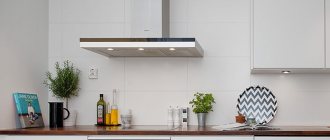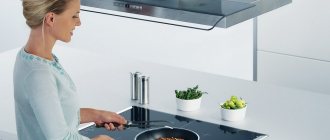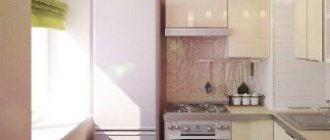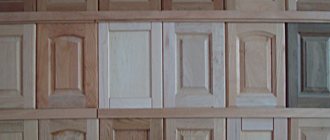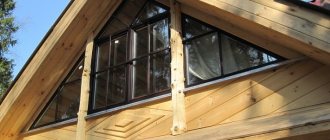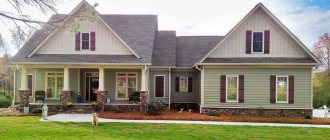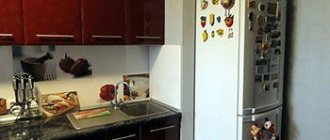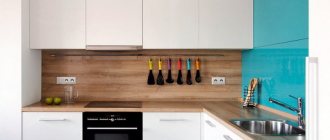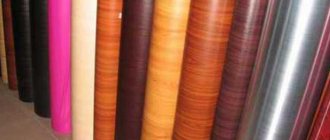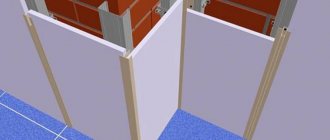What is a CBPB board?
Cement particle board (CPB) is a sheet building material that is made from high-quality cement (Portland cement) mixed with thin long wood chips (according to GOST 26816, chip thickness is 0.2-0.3 mm, length from 10 mm to 30 mm) . Aluminum sulfate and liquid glass are added to the composition. When kneading, water is added (about 8% of the total mass). The resulting substance is molded into slabs and pressed.
DSP board - sheet building material for interior and exterior work
Some manufacturers make CBPB boards from several layers. They separately mix compositions with smaller and larger chips. A mixture with large wood chips is used for the inner layers and gives greater strength. Outer layers are formed from a composition with smaller chips, which makes its surface smoother. The folded “pie” enters the press, resulting in the formation of a monolithic DSP board with improved characteristics.
These are DSP boards for exterior finishing of facades
It is also worth saying that there are polished and unpolished CBPB boards. Sanded ones can be used for interior or exterior finishing in those works that can be immediately followed by finishing work. There are also finishing DSP boards, on one of the surfaces of which a finishing layer is formed in the form of stone or brickwork, decorative plaster, etc.
How to seal DSP joints
Since cement particle board has thermal expansion, the boards are not laid close to each other, but with a gap. Under hard flooring, the joints do not need to be sealed (open seam). The seams must be on the base (beam, joists, sheathing), so the joint will not be empty. For better insulation, a strip of waterproofing material is laid on the beam with an open seam. This can be thick polyethylene film, roofing felt or more modern waterproofing materials.
How to seal DSP joints on the floor
If the floor is made from DSP boards under a soft floor covering, the seam is filled with an elastic sealant. When choosing a sealant, make sure that after drying it remains elastic, otherwise it will simply crumble and sag. It must also be compatible with wood and cement. Copolymers are the best in this regard, but they are expensive.
There is another option for filling the joint between DSP boards on the floor - an elastic cord made of polyethylene foam. It is laid in the gap, and the top can be sealed or painted.
Application area
DSPs are mainly used in dry installation technologies. They are good for the construction of frame houses, since they do not emit harmful substances, have high strength, are low flammable, emit a small amount of smoke during a fire, and do not spread fire. Having high mechanical strength, they increase the rigidity of frame structures. All this makes frame houses sheathed with DSP safer and more reliable.
Cement particle boards are used for construction, finishing
Objects for using DSP
DSP sheets can be used in the construction of the following objects:
- Frame residential buildings up to 3 floors inclusive.
- Industrial, office buildings.
- Hotel complexes.
- Kindergartens, schools.
- Medical institutions.
- Sport halls.
- Warehouses, hangars.
Disadvantage: the DSP board has a significant mass (several times heavier than OSB), which increases the requirements for the foundation. The heavy weight also becomes a problem when climbing to the second floor - you need helpers and scaffolding or lifting equipment (at least a winch). Another disadvantage of DSP is its low resistance to bending loads. This limits their scope of application - they are placed on the base, in places with low bending load, or must be mounted vertically.
Frame houses are built using DSP
Resistance to weathering and high humidity, fungi and bacterial infections allows the use of cement-bonded particle boards in the construction of outbuildings: sheds, outdoor toilets, cellar garages.
For finishing external and internal works
Another area of application for cement particle boards is leveling floors and walls. Compared to other materials, the DSP board has better sound insulation characteristics, is not susceptible to fungi, and tolerates climatic influences well. Therefore, they are often used to create ventilated facades.
Examples of using DSP in the construction and finishing of private houses
For interior finishing, DSP boards can be used for the following work:
- Soundproof and fire-resistant partitions and walls.
- Internal cladding of premises for any purpose (residential and non-residential, including those with high humidity).
- Window sills.
- Rough floor.
- Ceilings.
The positive point is that there are cement bonded particle boards, sanded and unsanded. Polished ones have an absolutely smooth surface. When using them, you can only seal the seams and then paint, glue wallpaper, or use other finishing methods.
Advantages and disadvantages
Like any building material, DSP has a number of advantages and disadvantages. The advantages of such plates include:
- The material is very resistant to moisture and temperature changes. The slabs can withstand up to 50 frost cycles. This characteristic significantly affects the service life of the slabs.
- The raw materials used to create such partitions are absolutely safe for human health. DSP does not release harmful toxins and does not cause allergic reactions.
- Cement bonded particle board is perfect for various transformations. With it you can use any finishing methods and change the surface of the product at your own request.
- A wide range of. In modern construction stores you can find a wide variety of products.
- The affordable price is an important advantage. Since the material is often used when building a home from scratch, purchasing large quantities of material will not negatively impact your budget.
- Plates of this type are very durable.
- An important feature when using DSP as interior partitions is their good sound absorption. They create the necessary level of sound insulation and additional comfort in the room.
- Unlike some other materials, DSP is not exposed to parasites, harmful insects or rodents that may periodically appear in a private home.
- The material is not subject to instant fire. The stove can only ignite when exposed to an open flame.
- DSPs are very durable. Such slabs can last for decades.
- Cement-bonded products are easy to use. On such a surface it is convenient to carry out various repair work using a drill, hammer drill or knife.
- The fixed size of the products significantly simplifies the installation process.
- The material is resistant to rotting processes.
- When a cement-bonded particle board is used to screed floors, it contributes to significant cost savings compared, for example, with self-leveling compounds or a cement-sand leveling option.
The negative properties of DSP include:
- Products can reach a large mass, which significantly complicates their use in high rooms. The high weight is due to the high density of the material.
- The material is not plastic. If you try to bend such a slab, you can break it. The risk of breakdown during construction work explains the need to purchase material in reserve.
Based on the presented data, it is clear that DSP has significantly more advantages than disadvantages. The disadvantages of such products are easily compensated by their advantages.
Characteristics and properties
DSP board is a relatively new material, not yet widely used in private construction. This is because not everyone understands how he behaves in the long term. To understand whether it is good or not for your purposes, you need to know about all the properties.
Density and mass
Density of CBPB is 1100-1400 kg/m³. High density gives frame structures an increased level of rigidity. If this material is used for interior finishing work, such walls have sufficient load-bearing capacity to support shelves, cabinets and other fairly heavy objects.
Specific resistance to pulling out self-tapping screws from a CBPB board
The material is quite dense and heavy. One sheet with a height of 2700 mm - depending on the thickness - weighs from 37 kg to 164 kg. This makes it inconvenient to cover the second floor and above. This can be considered a disadvantage.
Thermal and humidity expansion
Another important characteristic for construction is linear expansion with changes in humidity and temperature. For a CBPB board it is present, but it is small. When placing the plates one next to the other, it is recommended to leave a gap of 2-3 mm between them. When installing the second row (in height), the recommended gap is 8-10 mm.
- Normal humidity for sale is 9% (±3%).
- Low water absorption allows this type of material to be used for exterior finishing and for covering walls in rooms with high humidity. When in water for 24 hours, the limit for thickness increase is no more than 1.5%. That is, when wet they hardly change size.
What else is worth knowing: when immersed in water, the dimensions change slightly - 2% in thickness and 3% in length. If the material is made according to technology, then even after a long stay outdoors in the open air, it does not change for years.
Strength indicators and installation features
Cement particle boards do not tolerate bending deformations well, but have very high strength under longitudinal loads. Therefore, they are used for installation on vertical surfaces. Manufacturers do not recommend laying them on joists, but when laid on a subfloor or rough screed, the material behaves stably. Since the DSP board is not afraid of water, it can be laid on the floor in rooms with high humidity.
Elastic modulus:
- in compression and bending 2500 MPa;
- tensile strength - 3000 MPa;
- in shear - 1200 MPa.
If the CBPB is mounted on a frame, sheathing is required in increments of at least 60 cm. During installation, fasteners are installed in increments of 20 cm. We install self-tapping screws not only along the perimeter, but also along the intermediate rivers of the sheathing. In this case, tiles can be glued onto the DSP board (a primer, after it dries - not an adhesive composition, the tiles can be laid).
Fire hazard and frost resistance
The DSP board is a hard-to-burn material; fire does not spread across the surface; toxic or harmful gases are not released during combustion. Fire resistance limit (ability to contain fire) - 50 min. This means that the material will collapse after 50 minutes in the fire.
High frost resistance - the decrease in strength after 50 freezing/thawing cycles is no more than 10%, which allows the material to be used for building houses even in the Far North. The service life of this material outdoors is 50 years.
Comparison of DSP and OSB in terms of flammability
It is these properties that make DSP the more preferable material in frame house construction. The structure turns out to be more reliable in terms of fire safety.
Soundproofing properties
The DSP board has good soundproofing characteristics and can be used for cladding external or internal walls:
- reduction in air noise level for a slab with a thickness of 10 mm is about 30 dB, for a slab with a thickness of 12 mm - 31 dB;
- reduction in the level of impact noise for slabs laid on a reinforced concrete floor - with a thickness of 20 mm is 16 dB, with a thickness of 24 mm - 17 dB;
When using additional intermediate layers, impact noise becomes quieter by another 9-10 dB. That is, frame walls covered with DSP boards block enough sound to keep the house quiet.
The best combination is a combination of cement bonded particle board and mineral wool. Mineral wool also serves as insulation, since, due to the homogeneity of the DSP, it has a low thermal resistance (it is not a thermal insulation material).
Performance characteristics
DSP boards are characterized by high vapor permeability - 0.03 - 0.23 mg/(m·h·Pa). This is about the same level as natural wood. With the correct selection of wall coverings, the humidity in the rooms will be regulated naturally.
In addition, the DSP board has high resistance to rotting. This happens due to the natural process of formation of calcium hydroxide, which is formed during the transformation of cement into concrete and alkalizes the material so that it becomes an unfavorable environment for the habitat of fungi, insects and putrefactive bacteria.
Features of installation and finishing
Cement-bonded bonding materials are intended for dry installation. In construction and finishing works, they perform the same functions as chipboard, plywood, plasterboard, slate, and concrete plaster.
Some use cases:
- construction of permanent formwork during the construction of buildings, including multi-storey buildings;
- finishing, restoration of facades, foundations;
- basis for fencing, protective structures;
- arrangement of garden paths;
- creation of ceiling coverings, interior partitions, bases for roofs, floors;
- insulation, lining of fireplaces, stoves, chimneys.
Cement particle boards are used in many types of construction and repair work . They cut perfectly, do not crumble when drilling holes for fasteners, and hold plaster and primer mixtures, paint, ceramic tiles, and wallpaper. This is an excellent base for creating various designs and interiors.
When using DSP, the main attention must be paid to storage and transportation . The material contains cement and mineral additives, so it is quite fragile and can be damaged as a result of improper loads. Before use, sheets must be in a horizontal position and supported. When transporting, the material must be placed on its edge.
During installation, the sheets are fixed to the surface at least at three points . For vertical installation, use material with a thickness of about 15–20 mm. Holes for fasteners are drilled in advance. When moving slabs from place to place, precautions must be taken. When sawing, tools with working surfaces of increased hardness are used.
Putty is not used to seal joining joints . Cement particle board mainly consists of natural components, so during operation it can expand and contract. Visually, these changes are invisible, but rigid fixation can cause disruption of the integrity of the seams and the appearance of cracks in them. Typically, the gaps between the sheets are masked with silicone sealants and sewn up with narrow wooden slats or a metal profile.
The surface formed by cement particle boards is strong, stable, and does not require additional leveling or complex finishing. There is no need to soak in antiseptics or smooth out defects. The material can be coated on top with a primer to increase adhesion. Then paint or paste over it. DSP is an excellent basis for carpet, linoleum, laminate, mosaic tiles, and other finishing materials.
Dimensions and weight
When purchasing materials for construction and finishing work, such characteristics as the size and weight of the material are important. DSP sheets are available in two sizes: with a width of 1250 mm, the length can be 2700 or 3200 mm. In this case, the thickness of the DSP boards can be 8, 10, 12, 16, 20, 24, 36 mm.
DSP board: scope depending on thickness
It is clear that the thicker the slab, the greater its mass. Approximate weight values are given in the table (different manufacturers may have deviations both in the direction of increasing and decreasing weight).
Weight of cement bonded particle boards depending on size and thickness
You may also need the following parameters:
- area of one sheet: 1250*2700 - 3.375 m²;
- 1250*3200 - 4.0 m²;
The DSP sheet is a homogeneous monolithic material without air inclusions, which explains the high thermal conductivity of the material. This must be taken into account when developing an insulation cake. The material adheres well to wood, polymers and metal, so it is convenient for construction work.
General information
Compound
When wood is introduced into the composition, the density of the slab decreases, the most important thing is that the shavings play the role of not only a light filler, but also fiber - a special additive that creates the effect of volumetric reinforcement that takes tensile loads.
The mixture includes the following elements:
• Cement – 66%. • Chips – 23%. • Water – 8%. • Hydration and mineral supplements – 3%.
Manufacturing process
Making the mixture begins with grinding the chips to the required size. After this, it is divided into 2 fractions on a sieve. Fine-fraction chips are used to create the outer layer of the sheet, and coarse-fraction chips are used for the middle layer. After this, it is treated with calcium chloride, aluminum sulfate/chloride, and “liquid glass”. This is required in order to protect the material from fungal attack and rotting.
Mineral additives after sifting and processing are mixed with cement and water. Additives should be dissolved in water to speed up the hardening of the cement. In addition to the main components described, industrial oil I-20 and fuel oil are added to the mixture in small quantities in order to reduce internal friction and facilitate the pressing process.
The finished mixture is laid out on pallets in three layers, the pallets themselves are stacked and placed under a cold press, in which the package will be compressed to a pressure of 1.85 to 6.65 PMa and fixed in this form with locks. A special locking system allows pressure to be maintained in the mold after the mixture is removed from the press.
Compressed packages of future cement particle boards are heated for 480 minutes. During this time, an accelerated process of cement hydration and hardening will take place. Due to its elasticity, wood chips compensate for the shrinkage of cement, and therefore the specified size of the slabs will not be changed. Unlocking the molds and releasing pressure also occurs inside the press. After this, the package needs to be opened, and the slabs taken out and placed in a buffer warehouse for a couple of weeks. In order for the material to ripen completely, it should be blown with air at a temperature of +70 to +100 degrees. After this, I cut the sheets to a given size, grind them, sort them and send them to finished product warehouses.
Varieties and dimensions
According to GOST 26816-2016, cement particle boards are produced in only two grades - TsSP-1 and TsSP-2. They differ from each other in dimensional accuracy, strength and other parameters.
Parameters of DSP-1 DSP-2
Deviations in the size of slabs (mm) 3 5 Deviations in the thickness of slabs that were not sanded (mm) From 0.7 to 1.5 From 0.8 to 1.6 Bending strength (MPa) From 9 to 12 From 7 to 9 Ultimate delamination strength (MPa) 0.51 0.36 Roughness of slabs after grinding (µm) 80 100 Spots on the tile surface Not acceptable Not acceptable more than 1 piece with a diameter greater than 2 cm per 1 m2. Dents More than 1 piece with a depth of more than 0.1 cm and a diameter of more than 1 cm per 1 m2 is not allowed. More than 3 pieces with a depth of more than 0.2 cm and a diameter of more than 2 cm per 1 m2 are not allowed. Deviation limits for bending strength and thickness are set separately for different thickness ranges. Plates can be with a thickness of 0.8 to 4 cm with gradation every 0.2 cm. The dimensions of the sheets are the same for both brands:
• Length – 320 or 360 cm. • Width – 120 or 125 cm.
In addition to these brands, there are similar materials that have similar composition and properties.
Analogs
Fibrolite
These are special boards filled with wood fibers, or more precisely, wood wool. This type of filler has better fiberization, and this has a positive effect on the final strength of the material and resistance to cracking. We note that fiberboard is a relatively soft material, has a relatively low density and for this reason it is often used as a sound absorber and for thermal insulation.
Arbolit
This material belongs to the type of lightweight concrete. Wood shavings, wood chips and chopped reed stalks and rice straw are used as filler. Wood concrete has low strength, so it is used in structures that do not bear loads, for example, for internal partitions.
Xylolite
This material is made using a special magnesium binder, namely Sorel cement, which is insensitive to water. It is used for cladding floors, roofs and other structures where the slabs will often get wet.
Mounting methods
The DSP board can be fastened with nails or self-tapping screws. When mounted on a frame, the slabs must be mounted strictly vertically .
Scope of application of cement bonded particle boards in private construction
To fasten cement bonded particle boards you can use:
- Galvanized screw nails with a diameter of 2.5 mm. The length is selected depending on the thickness of the sheet and the entire cake. The pinched part of the nail must be at least twice the thickness of the slab, but not less than 10 nail diameters.
- Screws and self-tapping screws with pre-drilled holes for the heads. The length is chosen according to the same principle.
When installing CBPB slabs, it is necessary to strictly monitor the quantity and order of installation of fasteners: the material has a large mass, so fasteners must be installed at least as recommended. The distance between nails or screws depends on the thickness of the slab and is indicated in the table.
How and with what frequency to install fasteners when installing DSP
Each sheet of cement bonded particle board is fixed around the perimeter, departing a certain distance from the edge of the sheet. The frequency of installation along the long and short sides of the sheet is the same, but depends on the thickness of the material. In addition, there is also an intermediate mount - in the middle of the height. Here, the frequency of installing screws or nails is half as often as around the perimeter.
Projects of houses with fiber cement panels
Number of projects 37
- 4 rooms
- 2 bathrooms
Half-timbered House Project
- To favorites
- 107² Total area
- 8 x 8m Construction area
from 1,737,900 rub.
Construction time individually
High rating
- 4 rooms
- 2 bathrooms
Project Versailles
- To favorites
- 150² Total area
from 3,226,000 rub.
Construction time individually
Available at the exhibition
- 5 rooms
- 2 bathrooms
Project of the House Ekaterina
- To favorites
- 121.16² Total area
- 10 x 7m Construction area
from 1,450,000 rub.
Construction time individually
- 3 rooms
- 1 bathroom
Terem House Project
- To favorites
- 108² Total area
- 9 x 6m Construction area
from 747,600 rub.
Construction time individually
Available at the exhibition
- 6 rooms
- 2 bathrooms
Toronto House Project
- To favorites
- 115² Total area
- 8 x 8m Construction area
from 970,000 rub.
Construction time individually
- 5 rooms
- 2 bathrooms
House Project Zurich-1
- To favorites
- 171² Total area
- 9 x 9m Construction area
from 1,460,000 rub.
Construction time individually
- 3 rooms
- 2 bathrooms
Project of the Avenche House with facade
- To favorites
- 144² Total area
- 8 x 9m Construction area
from 1,834,000 rub.
Construction time individually
- 3 rooms
- 2 bathrooms
Manderfeld House Project
- To favorites
- 207² Total area
- 13 x 8m Construction area
from 1,647,000 rub.
Construction time individually
- 3 rooms
- 2 bathrooms
House Project Basel
- To favorites
- 117² Total area
- 8 x 8m Construction area
from 1,150,000 rub.
Construction time individually
- 5 rooms
- 2 bathrooms
Schwyz House Project
- To favorites
- 137² Total area
- 8 x 9m Construction area
from 1,120,000 rub.
Construction time individually
- 4 rooms
- 2 bathrooms
Altdorf House Project
- To favorites
- 192² Total area
- 11 x 9m Construction area
from 1,490,000 rub.
Construction time individually
- 6 rooms
- 2 bathrooms
Project House Valencia
- To favorites
- 167² Total area
- 12 x 10m Construction area
from 1,134,000 rub.
Construction time individually
- 3 rooms
- 2 bathrooms
House Project Basel Compact
- To favorites
- 124² Total area
- 8 x 12m Construction area
from 1,150,000 rub.
Construction time individually
- 5 rooms
- 3 bathrooms
Nyon House Project
- To favorites
- 177² Total area
- 11 x 8m Construction area
from 1,440,000 rub.
Construction time individually
- 6 rooms
- 2 bathrooms
House Project Zurich-4
- To favorites
- 217² Total area
- 10 x 10m Construction area
from 1,809,000 rub.
Construction time individually
- 2 rooms
- 1 bathroom
Alaska House Project
- To favorites
- 118² Total area
- 9 x 8m Construction area
from 936,600 rub.
Construction time individually
- 3 rooms
- 1 bathroom
Cascade House Project
- To favorites
- 75² Total area
- 7 x 7m Construction area
from 850,000 rub.
Construction time individually
- 7 rooms
- 3 bathrooms
Flagship House Project
- To favorites
- 246² Total area
- 10 x 14m Construction area
from 2,746,000 rub.
Construction time individually
- 5 rooms
- 2 bathrooms
Nice House Project
- To favorites
- 151² Total area
- 9 x 9m Construction area
from 1,515,000 rub.
Construction time individually
Available at the exhibition
- 4 rooms
- 3 bathrooms
House Project K1.1-B1.1
- To favorites
- 140² Total area
- 9 x 8m Construction area
from 2,999,000 rub.
Construction time individually
View all projects
The DSP board, the characteristics and application of which we will consider further, is a composite material. It is created by mixing Portland cement and wood shavings. At first glance, a contradictory alliance of materials, in fact, provides many positive properties.
DSP of various thicknesses Source tildacdn.com
Advantages and disadvantages of DSP
Cement-bonded particle board materials have the positive qualities of natural wood and stone. They:
- durable;
- resistant to adverse conditions, high and low temperatures;
- are not deformed;
- environmentally friendly, safe for health;
- absorb noise well;
- retain heat;
- not damaged by fungus, insects, rodents;
- durable;
- can be used in conditions of high humidity.
DSP production technologies make it possible to produce sheets with specified characteristics. This significantly reduces the time and costs of work. Practicality and versatility make DSP a popular building material . With their help, you can quickly erect building frames and perform any types of finishing. The composite has versatile functions and eliminates the need for additional surface treatment. This allows you to significantly save money during construction and repairs.
Significant disadvantages of cement bonded particle boards include:
- high specific gravity. A standard sheet has a mass of 70 kg. This makes installation difficult. It is impossible to move the slabs alone. The heaviness of the material creates a high additional load on the supporting structures;
- DSPs are not plastic and are quite brittle. They cannot be bent, and with strong impacts they are easy to damage and break;
- During manual and mechanical processing, the material emits a large amount of dust, so it is necessary to use special protective equipment for the respiratory system and eyes. After interior finishing, thorough cleaning of the premises is required.
If all rules for storing and installing the material are followed, the disadvantages are completely offset by the existing advantages.
